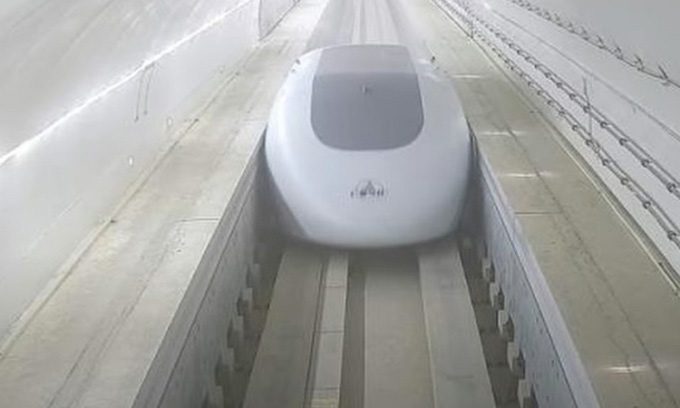China is likely to construct its first hyperloop train line between Shanghai and Hangzhou, which is estimated to reduce travel time by 15 minutes compared to driving or high-speed rail.
The 150 km vacuum tunnel will allow maglev trains to travel at speeds of up to 1,000 km/h. The Chinese Academy of Engineering and railway authorities are conducting a comprehensive evaluation of potential construction sites for the test route of the high-speed vacuum tube maglev system, with the two wealthiest cities on the eastern coast selected, according to a report published on April 17 in the journal Railway Standard Design.

Hyperloop capsule operating at the test facility. (Image: CASIC)
The Academy is responsible for providing scientific and engineering advice to the Chinese government. Leading scientists and engineers from the academy are directly involved in the brainstorming, design, and construction of the country’s largest infrastructure projects. The evaluation team is led by Zhang Yunjiao, an engineer at the China Railway Design and Consulting Group based in Beijing.
The high-speed vacuum tube maglev system, also known as hyperloop, was first proposed by billionaire Elon Musk in 2013. This transportation system uses vacuum tubes to transport passengers and goods. China is seriously considering the concept as it has the potential to revolutionize transportation, providing more efficient and faster ways to move people and goods. China is a leader in high-speed rail technology, and investment in hyperloop could help maintain its status in transportation initiatives.
According to Zhang and colleagues, the hyperloop project is strategically important for China. The train line is expected to be operational by 2035. Other potential routes are also being considered in the hyperloop project in China, including the Beijing-Shijiazhuang, Guangzhou-Shenzhen, and Chengdu-Chongqing routes. Each route has its own advantages.
The project team stated that they are considering several key factors for the project. They evaluate the economic potential of each route based on population density, economic activity, and existing infrastructure. The assessment process also includes technical feasibility, social impact, local policies, available funding, and the ability to integrate with existing transportation infrastructure. According to the report, the Shanghai-Hangzhou route is feasible and offers the most benefits for China.
This route has strong economic potential due to the high population density and bustling economic activity in both cities. Simultaneously, the technical feasibility is very high due to the relatively flat terrain. Such a project would also positively impact society by promoting regional integration between Shanghai and Hangzhou. Both are major cities in China with significant economic and cultural importance.
Shanghai, the most populous city in China, is a global financial center and hosts the world’s largest Tesla manufacturing plant operated by Musk. Meanwhile, Hangzhou is famous for its natural scenery and is home to e-commerce giants like Alibaba. With a distance of 200 km, it takes about 3 hours to travel between the two cities by car or one hour by high-speed rail. However, estimates suggest that the hyperloop train could reduce travel time to about 15 minutes.
The technical development required for the hyperloop system is still in the early stages. Before it can be implemented on a large scale, engineers need to overcome numerous technical challenges, such as building the necessary infrastructure, including low-pressure tubes and specialized stations. Additionally, they must also face legal challenges, as there are currently no regulations governing the operation of hyperloop systems. The high speeds of the hyperloop train mean that safety becomes a top concern that must be addressed during testing and development.




















































